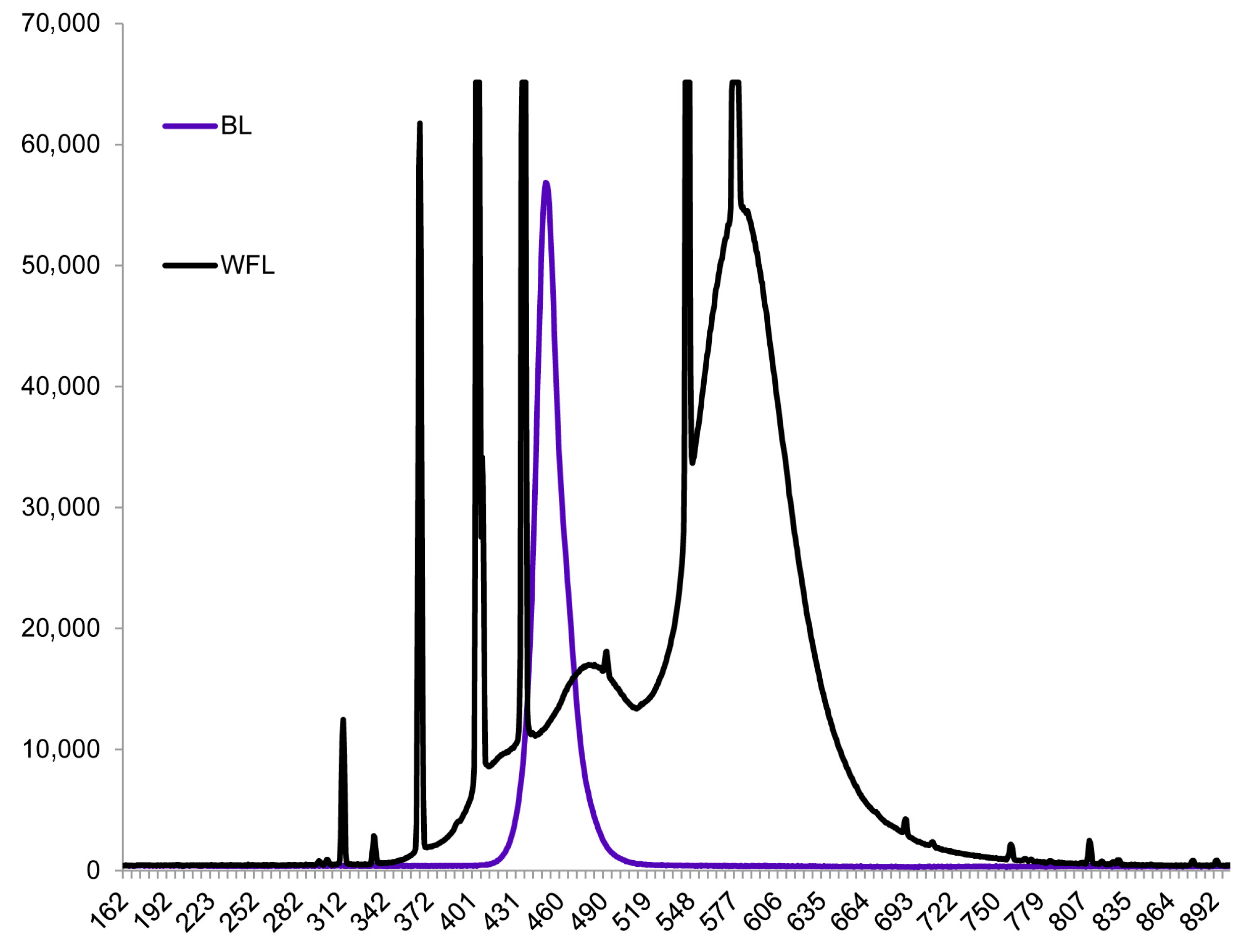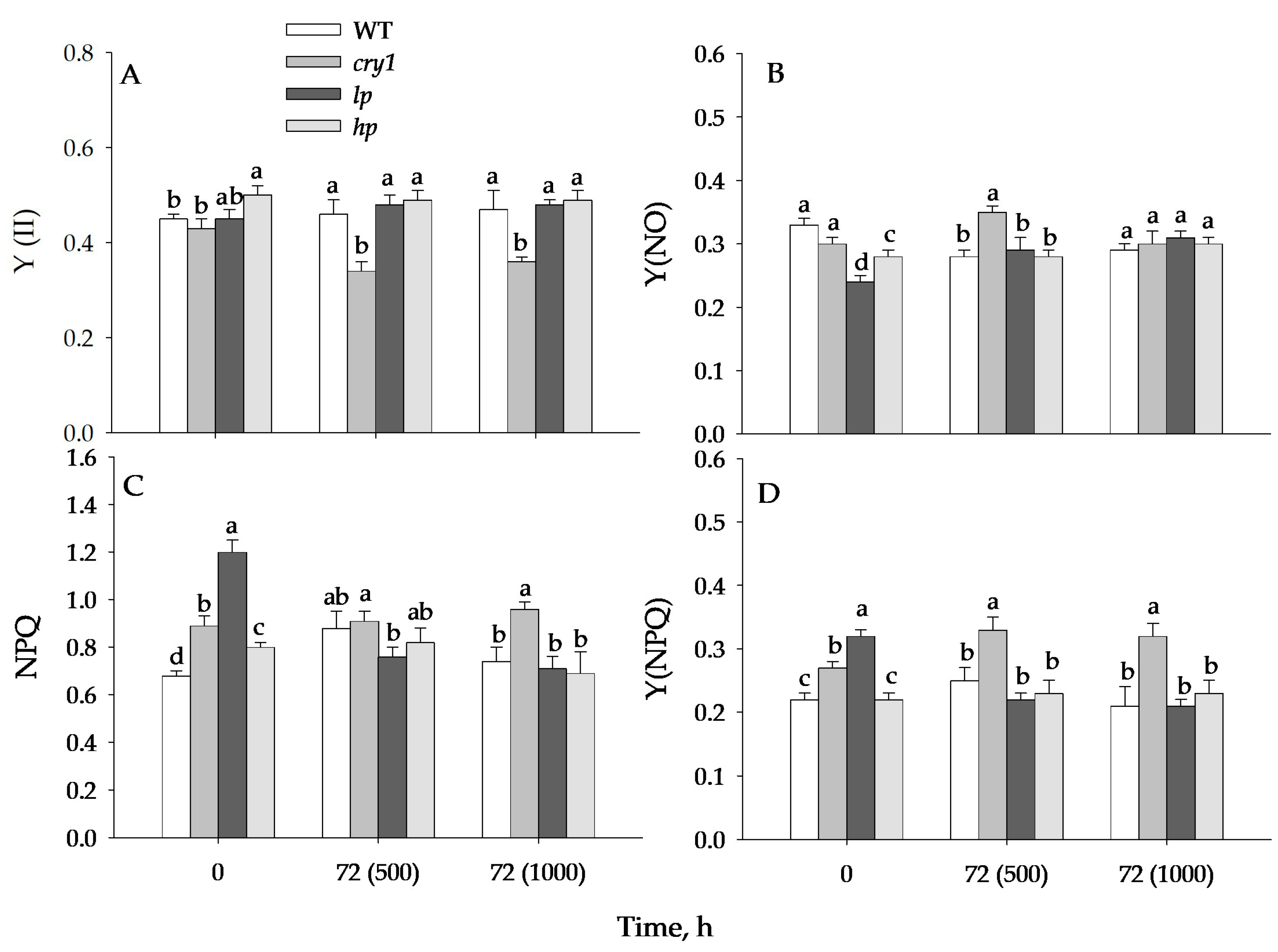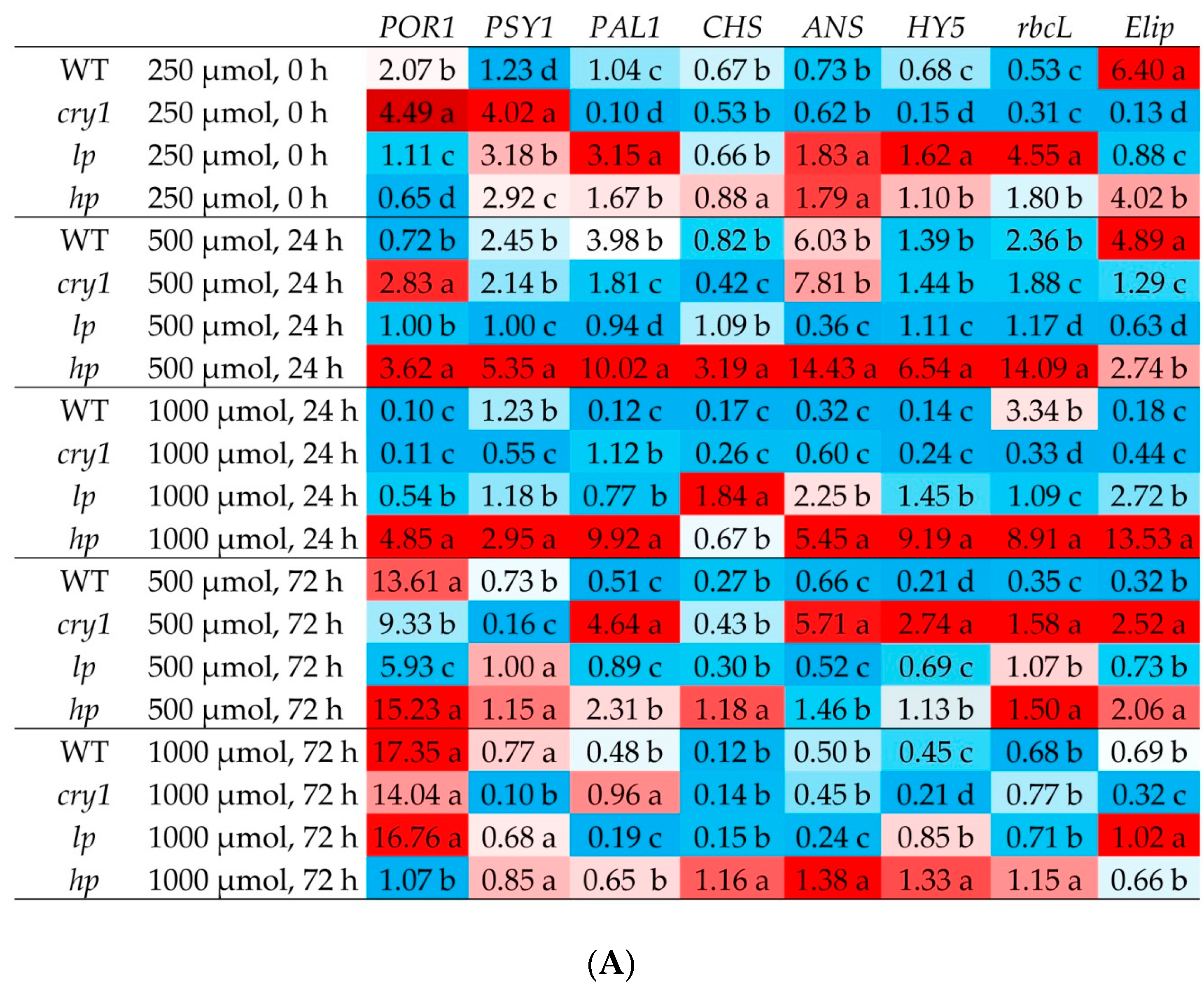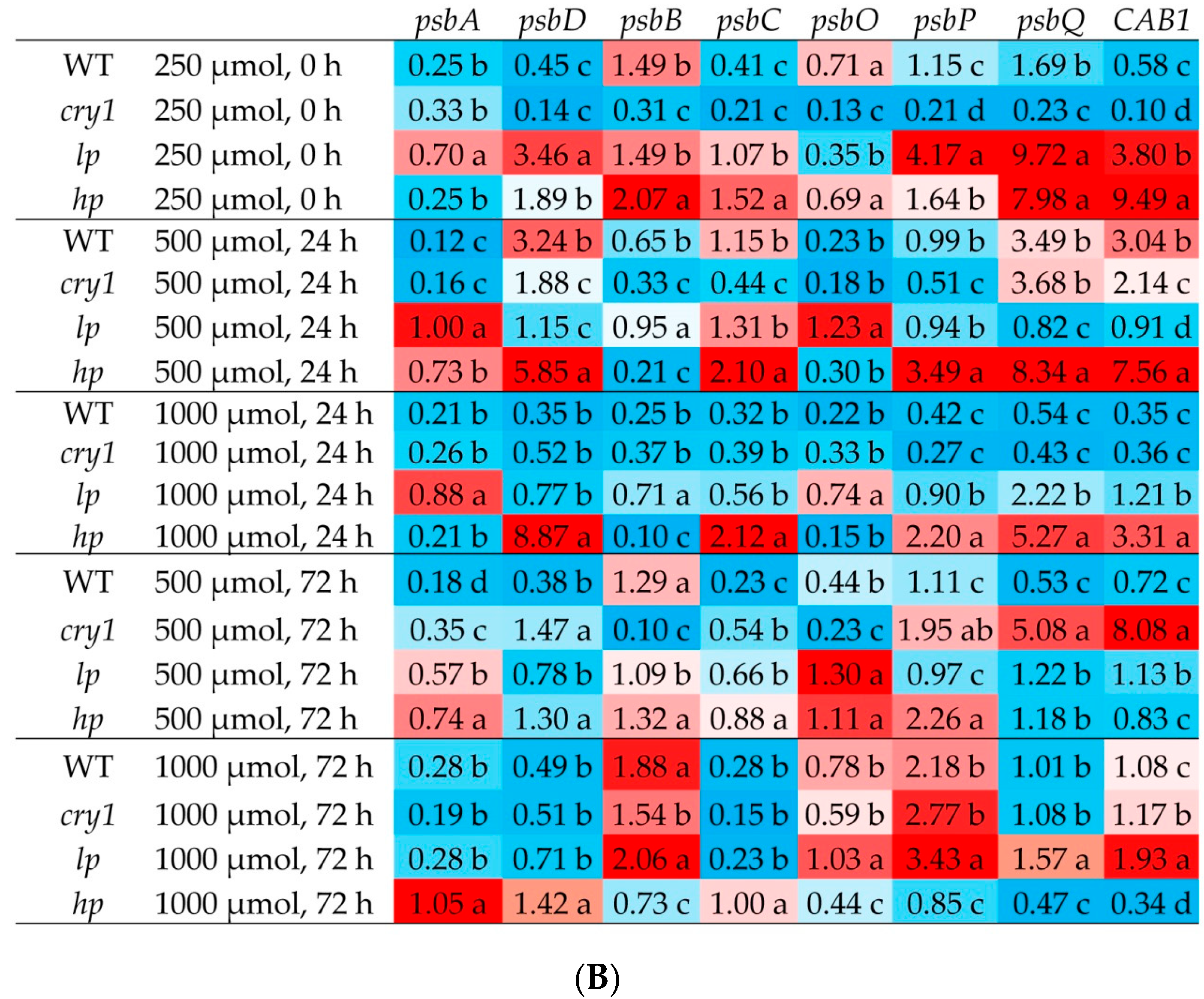The Role of Pigments and Cryptochrome 1 in the Adaptation of Solanum lycopersicum Photosynthetic Apparatus to High-Intensity Blue Light
Abstract
:1. Introduction
2. Materials and Methods
2.1. Plant Materials and Experimental Design
2.2. Photosynthesis and PAM Measurements
2.3. Contents of Photosynthetic Pigments, Phenols and Anthocyanins
2.4. Trolox Equivalent Antioxidant Capacity
2.5. HPLC Analysis of Carotenoids
2.6. RNA Extraction and RT—PCR
2.7. Statistical Data Processing
3. Results
3.1. Plant Phenotype
3.2. Photosynthesis and Transpiration Rates, Stomatal Conductance and Chlorophyll Fluorescence Parameters
3.3. PAM Parameters
3.4. Pigment Contents
3.5. Carotenoid Composition
3.6. Gene Expression
4. Discussion
5. Conclusions
Supplementary Materials
Author Contributions
Funding
Institutional Review Board Statement
Informed Consent Statement
Data Availability Statement
Acknowledgments
Conflicts of Interest
References
- Lauria, G.; Ceccant, C. Effects of Light Modulation on Plant Photosynthesis Process and Secondary Metabolism. Agrochimica 2021, 65, 45–51. [Google Scholar] [CrossRef]
- Jung, W.S.; Chung, I.M.; Hwang, M.H.; Kim, S.H.; Yu, C.Y.; Ghimire, B.K. Application of Light-Emitting Diodes for Improving the Nutritional Quality and Bioactive Compound Levels of Some Crops and Medicinal Plants. Molecules 2021, 26, 1477. [Google Scholar] [CrossRef]
- Muneer, S.; Kim, E.J.; Park, J.S.; Lee, J.H. Influence of Green, Red and Blue Light Emitting Diodes on Multiprotein Complex Proteins and Photosynthetic Activity under Different Light Intensities in Lettuce Leaves (Lactuca Sativa L.). Int. J. Mol. Sci. 2014, 15, 4657–4670. [Google Scholar] [CrossRef]
- Wang, X.Y.; Xu, X.M.; Cui, J. The Importance of Blue Light for Leaf Area Expansion, Development of Photosynthetic Apparatus, and Chloroplast Ultrastructure of Cucumis Sativus Grown under Weak Light. Photosynt. 2015, 53, 213–222. [Google Scholar] [CrossRef]
- Tuan, P.A.; Park, C.H.; Park, W.T.; Kim, Y.B.; Kim, Y.J.; Chung, S.O. Expression Level of Carotenoid Biosynthetic Genes and Carotenoid Production in the Callus of Scutellaria Baicalensis Exposed to White, Blue, and Red Light-Emitting Diodes. Appl. Biol. Chem 2017, 60, 591–596. [Google Scholar] [CrossRef]
- Dănăilă-Guidea, S.M.; Delian, E. An Overview on Blue Light Benefits on Plants Physiological Performances and on Plant Products Qualities. Sci. Papers. Ser. B Hortic. 2020, 64, 643–652. [Google Scholar]
- Hogewoning, S.W.; Trouwborst, G.; Maljaars, H.; Poorter, H.; van Ieperen, W.; Harbinson, J. Blue Light Dose–Responses of Leaf Photosynthesis, Morphology, and Chemical Composition of Cucumis Sativus Grown under Different Combinations of Red and Blue Light. J. Exp. Bot. 2010, 61, 3107–3117. [Google Scholar] [CrossRef]
- Le, A.T.; Phan, N.H.; Do, T.K. Effect of Blue Light on the Photosynthesis and Flavonoid Accumulation in Leaves of Hedyotis Corymbosa L. Lam. Plant Sci. Today 2021, 8, 955–962. [Google Scholar] [CrossRef]
- Ouzounis, T.; Razi Parjikolaei, B.; Frette, X.; Rosenqvist, E.; Ottosen, C.O. Predawn and High Intensity Application of Supplemental Blue Light Decreases the Quantum Yield of PSII and Enhances the Amount of Phenolic Acids, Flavonoids and Pigments in Lactuca sativa. Front. Plant Sci. 2015, 6, 19. [Google Scholar] [CrossRef]
- Rao, A.Q.; Ullah Khan, M.A.; Shahid, N. An Overview of Phytochrome: An Important Light Switch and Photo-Sensory Antenna for Regulation of Vital Functioning of Plants. Biology 2015, 70, 1273–1283. [Google Scholar] [CrossRef]
- Voitsekhovskaja, O.V. Phytochromes and Other (Photo)Receptors of Information in Plants. Russ. J. Plant Physiol. 2019, 66, 351–364. [Google Scholar] [CrossRef]
- Kreslavski, V.D.; Shmarev, A.N.; Lyubimov, V.Y.; Semenova, G.A.; Zharmukhamedov, S.K.; Shirshikova, G.N.; Khudyakova, A.Y.; Allakhverdiev, S.I. Response of Photosynthetic Apparatus in Arabidopsis Thaliana L. Mutant Deficient in Phytochrome A and B to UV-B. Photosynthetica 2018, 56, 418–426. [Google Scholar] [CrossRef]
- Kreslavski, V.D.; Strokina, V.V.; Pashkovskiy, P.P.; Balakhnina, T.I.; Voloshin, R.A.; Alwasel, S.; Kosobryukhov, A.A.; Allakhverdiev, S.I. Deficiencies in Phytochromes A and B and Cryptochrome 1 Affect the Resistance of the Photosynthetic Apparatus to High-Intensity Light in Solanum Lycopersicum. J. Photochem. Photobiol. B Biol. 2020, 210, 111976. [Google Scholar] [CrossRef] [PubMed]
- Kleine, T.; Kindgren, P.; Benedict, C.; Hendrickson, L.; Strand, A. Genome-Wide Gene Expression Analysis Reveals a Critical Role for CRYPTOCHROME1 in the Response of Arabidopsis to High Irradiance. Plant Physiol. 2007, 144, 1391–1406. [Google Scholar] [CrossRef] [PubMed]
- Schmitt, F.-J.; Renger, G.; Friedrich, T.; Kreslavski, V.D.; Zharmukhamedov, S.K.; Los, D.A.; Kuznetsov, V.V.; Allakhverdiev, S.I. Reactive Oxygen Species: Re-Evaluation of Generation, Monitoring and Role in Stress-Signaling in Phototrophic Organisms. Biochim. Et Biophys. Acta (BBA)-Bioenerg. 2014, 1837, 835–848. [Google Scholar] [CrossRef] [PubMed]
- Das, K.; Roychoudhury, A. Reactive Oxygen Species (ROS) and Response of Antioxidants as ROS-Scavengers during Environmental Stress in Plants. Front. Environ. Sci. 2014, 2, 53. [Google Scholar] [CrossRef]
- Borisova-Mubarakshina, M.M.; Ivanov, B.N.; Vetoshkina, D.V.; Lubimov, V.Y.; Fedorchuk, T.P.; Naydov, I.A. Long-Term Acclimatory Response to Excess Excitation Energy: Evidence for a Role of Hydrogen Peroxide in the Regulation of Photosystem II Antenna Size. J. Exp. Bot 2015, 66, 7151–7164. [Google Scholar] [CrossRef]
- Bhutta, M.A.; Bibi, A.; Ahmad, N.H.; Kanwal, S.; Amjad, Z.; Rehman, H.; Farooq, U.; Khalid, M.N.; Nayab5, S.F. Molecular Mechanisms of Photoinhibition in Plants: A Review. Sarhad J. Agric. 2023, 39, 340–345. [Google Scholar] [CrossRef]
- Solovchenko, A.E.; Merzlyak, M.N. Screening of Visible and UV Radiation as a Photoprotective Mechanism in Plants. Russ. J. Plant Physiol. 2008, 55, 719–737. [Google Scholar] [CrossRef]
- Carvalho, S.D.; Schwieterman, M.L.; CE, A. Light Quality Dependent Changes in Morphology, Antioxidant Capacity, and Volatile Production in Sweet Basil (Ocimum basilicum). Front. Plant Sci 2016, 7, 1328. [Google Scholar] [CrossRef]
- Yangen, F.; Xiuxiu, Z.; Hanyue, W.; Yueyue, T.; Qinzeng, X.; Lixia, Z. Effects of Light Intensity on Metabolism of Light-Harvesting Pigment and Photosynthetic System in Camellia Sinensis L. Cultivar “Huangjinya”. Environ. Exp. Bot 2019, 166, 103796. [Google Scholar] [CrossRef]
- Zulfiqar, S.; Sharif, S.; Saeed, M.; Tahir, A. Role of Carotenoids in Photosynthesis. In Carotenoids: Structure and Function in the Human Body; Zia-Ul-Haq, M., Dewanjee, S., Riaz, M., Eds.; Springer: Cham, Switzerland, 2021. [Google Scholar]
- Jahns, P.; Holzwarth, A.R. The Role of the Xanthophyll Cycle and of Lutein in Photoprotection of Photosystem II. Biochim. Biophys. Acta (BBA)-Bioenerg. 2012, 1817, 182–193. [Google Scholar] [CrossRef] [PubMed]
- Edge, R.; Truscott, G. Properties of Carotenoid Radicals and Excited States and Their Potential Role in Biological Systems. In Carotenoids; CRC Press: Boca Raton, FL, USA, 2010; pp. 283–307. [Google Scholar]
- Vetoshkina, D.; Balashov, N.; Ivanov, B.; Ashikhmin, A.; Borisova-Mubarakshina, M. Light Harvesting Regulation: A Versatile Network of Key Components Operating under Various Stress Conditions in Higher Plants. Plant Physiol. Biochem. 2023, 194, 576–588. [Google Scholar] [CrossRef] [PubMed]
- Ashikhmin, A.; Bolshakov, M.; Pashkovskiy, P.; Vereshchagin, M.; Khudyakova, A.; Shirshikova, G.; Kozhevnikova, A.; Kosobryukhov, A.; Kreslavski, V.; Kuznetsov, V.; et al. The Adaptive Role of Carotenoids and Anthocyanins in Solanum Lycopersicum Pigment Mutants under High Irradiance. Cells 2023, 12, 2569. [Google Scholar]
- Yu, X.; Liu, H.; Klejnot, J.; Lin, C. The Cryptochrome Blue Light Receptors. Arab. Book/Am. Soc. Plant Biol. 2010, 8, e0135. [Google Scholar] [CrossRef] [PubMed]
- Fantini, E.; Sulli, M.; Zhang, L.; Aprea, G.; Jiménez-Gómez, J.M.; Bendahmane, A.; Perrotta, G.; Giuliano, G.; Facella, P. Pivotal roles of cryptochromes 1a and 2 in tomato development and physiology. Plant Physiol. 2019, 17, 732–748. [Google Scholar] [CrossRef]
- Pratt, L.H.; Cordonnier-Pratt, M.M.; Kelmenson, P.M.; Lazarova, G.I.; Kubota, T.; Alba, R.M. The Phytochrome Gene Family in Tomato. Plant Cell Environ. 1997, 20, 672–677. [Google Scholar] [CrossRef]
- Pereira, A.M.; Martins, A.O.; Silva, W.B.; Apfata, J.A.C.; Nascimento, V.L.; Silva, V.F.; Oliveira, L.A.; Medeiros, D.B.; Martins, S.C.V.; Fernie, A.R.; et al. Elevated Carbon Assimilation and Metabolic Reprogramming in Tomato High Pigment Mutants Support the Increased Production of Pigments. Plant Cell Rep. 2022, 41, 1907–1929. [Google Scholar] [CrossRef] [PubMed]
- Levin, I.; De Vos, C.; Tadmor, Y.; Bovy, A.; Lieberman, M.; Oren-Shamir, M.; Segev, O.; Kolotilin, I.; Keller, M.; Ovadia, R.; et al. High Pigment Tomato Mutants—More than Just Lycopene (a Review). Isr. J. Plant Sci. 2006, 54, 179–190. [Google Scholar] [CrossRef]
- Kramer, D.M.; Johnson, G.; Kiirats, O.; Edwards, G.E. New Fluorescence Parameters for the Determination of QA Redox State and Excitation Energy Fluxes. Photosynth. Res. 2004, 79, 209–218. [Google Scholar] [CrossRef]
- Lichtenthaler, H.K. [34] Chlorophylls and Carotenoids: Pigments of Photosynthetic Biomembranes. In Methods in Enzymology; Plant Cell Membranes; Academic Press: Cambridge, MA, USA, 1987; Volume 148, pp. 350–382. [Google Scholar] [CrossRef]
- Liu, C.-C.; Chi, C.; Jin, L.-J.; Zhu, J.; Yu, J.-Q.; Zhou, Y.-H. The bZip Transcription Factor HY5 Mediates CRY1a -Induced Anthocyanin Biosynthesis in Tomato: HY5 Mediates CRY1a -Induced Anthocyanin Biosynthesis. Plant Cell Environ. 2018, 41, 1762–1775. [Google Scholar] [CrossRef]
- Singleton, V.L.; Rossi, J.A. Colorimetry of Total Phenolics with Phosphomolybdic-Phosphotungstic Acid Reagents. Am. J. Enol. Vitic. 1965, 16, 144–158. [Google Scholar] [CrossRef]
- Re, R.; Pellegrini, N.; Proteggente, A.; Pannala, A.; Yang, M.; Rice-Evans, C. Antioxidant Activity Applying an Improved ABTS Radical Cation Decolorization Assay. Free Radic. Biol. Med. 1999, 26, 1231–1237. [Google Scholar] [CrossRef]
- Ashikhmin, A.; Makhneva, Z.; Bolshakov, M.; Moskalenko, A. Incorporation of Spheroidene and Spheroidenone into Light-Harvesting Complexes from Purple Sulfur Bacteria. J. Photochem. Photobiol. B Biol. 2017, 170, 99–107. [Google Scholar] [CrossRef] [PubMed]
- Britton, G. Carotenoids. 1, B. Spectroscopy; Birkhäuser: Basel, Switzerland, 1995. [Google Scholar]
- Zavafer, A.; Mancilla, C. Concepts of Photochemical Damage of Photosystem II and the Role of Excessive Excitation. J. Photochem. Photobiol. C Photochem. Rev. 2021, 47, 100421. [Google Scholar] [CrossRef]
- Gould, K.S.; Jay-Allemand, C.; Logan, B.A. When Are Foliar Anthocyanins Useful to Plants? Re-Evaluation of the Photoprotection Hypothesis Using Arabidopsis Thaliana Mutants That Differ in Anthocyanin Accumulation. Environ. Exp. Bot. 2018, 154, 11–22. [Google Scholar] [CrossRef]
- Dall’Osto, L.; Cazzaniga, S.; North, H.; Marion-Poll, A.; Bassi, R. The Arabidopsis Aba4-1 Mutant Reveals a Specific Function for Neoxanthin in Protection against Photooxidative Stress. Plant Cell 2007, 19, 1048–1064. [Google Scholar] [CrossRef] [PubMed]
- Landi, M.; Guidi, L. Effects of Abiotic Stress on Photosystem II Proteins. Photosynthetica 2023, 61, 148–156. [Google Scholar] [CrossRef]
- Bharath, P.; Gahir, S.; Raghavendra, A.S. Abscisic Acid-Induced Stomatal Closure: An Important Component of Plant Defense against Abiotic and Biotic Stress. Front. Plant Sci 2021, 12, 615114. [Google Scholar] [CrossRef]
- Mao, J.; Zhang, Y.-C.; Sang, Y.; Li, Q.-H.; Yang, H.-Q. A Role for Arabidopsis Cryptochromes and COP1 in the Regulation of Stomatal Opening. Proc. Natl. Acad. Sci. USA 2005, 102, 12270–12275. [Google Scholar] [CrossRef]
- Tattini, M.; Landi, M.; Brunetti, C.; Giordano, C.; Remorini, D.; Gould, K.S.; Guidi, L. Epidermal Coumaroyl Anthocyanins Protect Sweet Basil against Excess Light Stress: Multiple Consequences of Light Attenuation. Physiol. Plant. 2014, 152, 585–598. [Google Scholar] [CrossRef] [PubMed]
- Tuladhar, P.; Sasidharan, S.; Saudagar, P. Role of phenols and polyphenols in plant defense response to biotic and abiotic stresses. In Biocontrol Agents and Secondary Metabolites; Woodhead Publishing: Sawston, UK, 2021; pp. 419–441. [Google Scholar]






| Option/Time (h) | 0 | 24 | 48 | 72 |
|---|---|---|---|---|
| Pn µmol CO2 m−2s−1 | ||||
| WT (500) | 4.4 ±0.9 a | 5.6 ± 0.3 ab | 9.2 ± 0.9 a | 8.6 ± 0.5 a |
| cry1 (500) | 3.4 ± 0.2 a | 3.4 ± 0.3 b | 4.6 ± 0.9 b | 3.1 ± 0.4 c |
| lp (500) | 5.0 ± 0.7 a | 4.3 ± 0.4 b | 7.8 ± 0.5 a | 7.0 ± 0.6 ab |
| hp (500) | 3.8 ± 0.5 a | 7.2 ± 0.5 a | 6.7 ± 0.6 ab | 6.2 ± 0.7 b |
| WT (1000) | 4.4 ± 0.9 a | 7.3 ± 0.7 b | 8.8 ± 0.6 b | 9.5 ± 0.6 b |
| cry1 (1000) | 3.4 ± 0.2 a | 4.5 ± 0.7 c | 3.4 ± 0.5 d | 2.9 ± 0.3 d |
| lp (1000) | 5.0 ± 0.7 a | 10.1 ± 0.6 a | 13.4 ± 0.8 a | 11.9 ± 0.7 a |
| hp (1000) | 3.8 ± 0.5 a | 8.5 ± 0.5 ab | 6.5 ± 0.5 c | 5.9 ± 0.6 c |
| E mmol H2O m−2s−1 | ||||
| WT (500) | 1.35 ± 0.38 ab | 1.33 ± 0.14 a | 2.00 ± 0.28 ab | 2.54 ± 0.31 a |
| cry1 (500) | 1.04 ± 0.07 b | 0.83 ± 0.11 b | 0.86 ± 0.09 c | 1.22 ± 0.04 c |
| lp (500) | 1.91 ± 0.28 a | 1.42 ± 0.10 a | 2.77 ± 0.31 a | 2.08 ± 0.27 a |
| hp (500) | 1.16 ± 0.10 b | 1.44 ± 0.12 a | 1.30 ± 0.15 b | 1.44 ± 0.08 b |
| WT (1000) | 1.35 ± 0.48 ab | 1.58 ± 0.15 ab | 1.90 ± 0.13 b | 2.04 ± 0.11 b |
| cry1 (1000) | 1.04 ± 0.07 b | 1.10 ± 0.16 b | 0.97 ± 0.16 c | 0.99 ± 0.09 d |
| lp (1000) | 1.91 ± 0.38 a | 2.13 ± 0.31 a | 3.18 ± 0.29 a | 2.94 ± 0.33 a |
| hp (1000) | 1.16 ± 0.10 ab | 1.79 ± 0.07 b | 1.38 ± 0.15 bc | 1.21 ± 0.07 c |
| Gs mmol m−2 s−1 | ||||
| WT (500) | 66.9 ± 8.9 ab | 75.4 ± 7.1 a | 123.1 ± 22.4 ab | 164.6 ± 28.1 a |
| cry1 (500) | 44.3 ± 5.4 b | 39.7 ± 7.2 b | 44.9 ± 7.8 c | 68.5 ± 3.3 c |
| lp (500) | 82.3 ± 9.5 a | 80.3 ± 5.4 a | 134.3 ± 27.4 a | 136.0 ± 14.1 a |
| hp (500) | 67.1 ± 7.7 ab | 79.8 ± 5.6 a | 83.0 ± 12.5 b | 89.6 ± 9.2 b |
| WT (1000) | 66.9 ± 26.9 ab | 80.2 ± 11.2 b | 106.5 ± 6.3 b | 117.3 ± 8.3 b |
| cry1 (1000) | 44.3 ± 5.4 b | 54.0 ± 10.7 c | 60.0 ± 9.6 c | 43.8 ± 2.2 d |
| lp (1000) | 82.3 ± 9.5 a | 117.1 ± 10.3 a | 187.9 ± 13.6 a | 194.1 ± 30.1 a |
| hp (1000) | 67.1 ± 7.7 ab | 94.2 ± 7.2 ab | 77.5 ± 6.9 c | 67.0 ± 5.5 c |
| Chl a | Chl b | Car | Phenols | Anthocyanins | ||
|---|---|---|---|---|---|---|
| WT | 250 µmol, 0 h | 11.8 ± 0.6 a | 3.9 ± 0.3 a | 3.01 ± 0.14 ab | 0.9 ± 0.1 a | 1.1 ± 0.1 a |
| cry1 | 250 µmol, 0 h | 8.3 ± 0.4 b | 2.6 ± 0.2 c | 2.25 ± 0.09 b | 0.7 ± 0.1 b | 0.9 ± 0.1 a |
| lp | 250 µmol, 0 h | 9.3 ± 0.7 b | 3.3 ± 0.3 b | 2.59 ± 0.31 b | 0.7 ± 0.1 b | 1.1 ± 0.1 a |
| hp | 250 µmol, 0 h | 12.8 ± 0.7 a | 3.9 ± 0.4 a | 3.24 ± 0.22 a | 0.9 ± 0.1 a | 1.3 ± 0.1 a |
| WT | 500 µmol, 24 h | 6.8 ± 0.3 b | 2.3 ± 0.1 b | 1.93 ± 0.15 c | 1.5 ± 0.3 a | 1.6 ± 0.1 b |
| cry1 | 500 µmol, 24 h | 8.2 ± 0.5 a | 3.3 ± 0.2 a | 2.44 ± 0.07 b | 1.4 ± 0.1 a | 1.0 ± 0.2 c |
| lp | 500 µmol, 24 h | 9.5 ± 0.2 a | 3.2 ± 0.1 a | 2.66 ± 0.18 a | 1.3 ± 0.1 a | 0.9 ± 0.1 c |
| hp | 500 µmol, 24 h | 7.9 ± 0.4 b | 2.3 ± 0.4 b | 2.24 ± 0.16 c | 1.5 ± 0.1 a | 2.6 ± 0.4 a |
| WT | 1000 µmol, 24 h | 6.7 ± 0.5 ab | 2.2 ± 0.3 b | 2.89 ± 0.11 a | 1.4 ± 0.5 b | 1.5 ± 0.1 b |
| cry1 | 1000 µmol, 24 h | 6.2 ± 0.5 b | 2.1 ± 0.3 b | 2.14 ± 0.17 c | 1.8 ± 0.1 ab | 0.8 ± 0.1 c |
| lp | 1000 µmol, 24 h | 7.6 ± 0.7 a | 2.7 ± 0.4 a | 2.42 ± 0.13 b | 2.1 ± 0.2 a | 1.4 ± 0.1 b |
| hp | 1000 µmol, 24 h | 7.1 ± 0.5 a | 2.0 ± 0.3 b | 2.01 ± 0.07 c | 1.8 ± 0.2 ab | 2.9 ± 0.2 a |
| WT | 500 µmol, 72 h | 10.8 ± 0.4 a | 3.2 ± 0.2 a | 2.07± 0.12 a | 3.2 ± 0.1 a | 2.1 ± 0.1 b |
| cry1 | 500 µmol, 72 h | 7.2 ± 0.2 c | 2.6 ± 0.1 b | 1.82 ± 0.15 a | 1.0 ± 0.3 c | 0.8 ± 0.1 d |
| lp | 500 µmol, 72 h | 8.7 ± 0.2 b | 2.5 ± 0.2 b | 2.18 ± 0.22 a | 1.5 ± 0.2 b | 1.2 ± 0.1 c |
| hp | 500 µmol, 72 h | 7.3 ± 0.2 c | 2.4 ± 0.2 b | 2.11 ± 0.23 a | 3.6 ± 0.2 a | 3.4 ± 0.1 a |
| WT | 1000 µmol, 72 h | 8.2 ± 0.3 a | 2.5 ± 0.2 a | 2.42 ± 0.15 b | 3.0 ± 0.1 b | 2.9 ± 0.1 b |
| cry1 | 1000 µmol, 72 h | 7.2 ± 0.2 b | 2.2 ± 0.2 a | 2.09 ± 0.14 c | 0.9 ± 0.1 d | 1.1 ± 0.1 d |
| lp | 1000 µmol, 72 h | 8.6 ± 0.2 a | 2.5 ± 0.2 a | 2.61 ± 0.13 a | 1.8 ± 0.1 c | 1.7 ± 0.1 c |
| hp | 1000 µmol, 72 h | 5.2 ± 0.2 c | 1.4 ± 0.2 b | 1.66 ± 0.13 d | 4.1 ± 0.3 a | 5.0 ± 0.3 a |
Disclaimer/Publisher’s Note: The statements, opinions and data contained in all publications are solely those of the individual author(s) and contributor(s) and not of MDPI and/or the editor(s). MDPI and/or the editor(s) disclaim responsibility for any injury to people or property resulting from any ideas, methods, instructions or products referred to in the content. |
© 2024 by the authors. Licensee MDPI, Basel, Switzerland. This article is an open access article distributed under the terms and conditions of the Creative Commons Attribution (CC BY) license (https://creativecommons.org/licenses/by/4.0/).
Share and Cite
Ashikhmin, A.; Pashkovskiy, P.; Kosobryukhov, A.; Khudyakova, A.; Abramova, A.; Vereshchagin, M.; Bolshakov, M.; Kreslavski, V. The Role of Pigments and Cryptochrome 1 in the Adaptation of Solanum lycopersicum Photosynthetic Apparatus to High-Intensity Blue Light. Antioxidants 2024, 13, 605. https://doi.org/10.3390/antiox13050605
Ashikhmin A, Pashkovskiy P, Kosobryukhov A, Khudyakova A, Abramova A, Vereshchagin M, Bolshakov M, Kreslavski V. The Role of Pigments and Cryptochrome 1 in the Adaptation of Solanum lycopersicum Photosynthetic Apparatus to High-Intensity Blue Light. Antioxidants. 2024; 13(5):605. https://doi.org/10.3390/antiox13050605
Chicago/Turabian StyleAshikhmin, Aleksandr, Pavel Pashkovskiy, Anatoliy Kosobryukhov, Alexandra Khudyakova, Anna Abramova, Mikhail Vereshchagin, Maksim Bolshakov, and Vladimir Kreslavski. 2024. "The Role of Pigments and Cryptochrome 1 in the Adaptation of Solanum lycopersicum Photosynthetic Apparatus to High-Intensity Blue Light" Antioxidants 13, no. 5: 605. https://doi.org/10.3390/antiox13050605
APA StyleAshikhmin, A., Pashkovskiy, P., Kosobryukhov, A., Khudyakova, A., Abramova, A., Vereshchagin, M., Bolshakov, M., & Kreslavski, V. (2024). The Role of Pigments and Cryptochrome 1 in the Adaptation of Solanum lycopersicum Photosynthetic Apparatus to High-Intensity Blue Light. Antioxidants, 13(5), 605. https://doi.org/10.3390/antiox13050605










